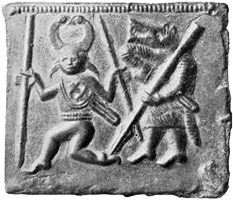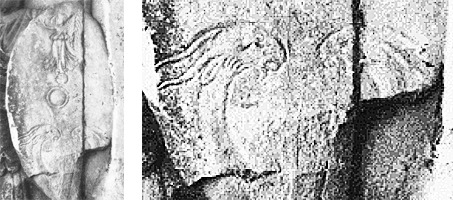
This page created 12 July 2014, and last modified: 28 October (Frankfurt fragment image added)

In the western half of the empire, one of the auxilia palatina units listed in the Magister Peditum's infantry roster is called the Batavi iuniores; it is placed between the Victores iuniores and the Bructeri. The shield pattern in the corresponding place in the illustrations section as shown in various manuscripts under the simple label Batavi is as below:

The shield pattern has a red ground with a purple version (green in W) of the twin-headed zoomorphic motif that is extremely common in the Notitia (over a dozen examples), especially amongst auxilia palatina: this version has the "pole" or pillar differentiated by being white, and (except in B) the pillar bears 4 or 5 black chevrons with their points down.
In addition to its numerous appearances in the Notitia, the twin-headed zoomorphic motif is known from a range of sources in northern Europe, such as on the ca. 6th century Torslunda bronze die from Sweden shown below:

It can also be seen on a shield depicted on the Arch of Constantine, completed ca. 315 in Rome, in a scene showing the siege of Verona in 312:

A winged Victory stands above the shield's boss, while below, we see two horned creatures, possibly goats, facing each other, and with their necks curving in towards each other (and interpreted by Michael P. Spiedel in "Ancient Germanic Warriors: Warrior styles from Trajan's Column to Icelandic sagas", Routledge, 2004, as dragons). As with many other western units of auxilia palatina, there is evidence that the shield pattern shown above may be "incorrect", in that it may have been shifted from its proper place (or, to be more exact, the label may have been shifted from its proper place), although which pattern (if any) among those shown properly belongs to the unit is hard to discern.
The Batavi (iuniores) is apparently assigned to the Magister Equitum's Gallic command. "Apparently", because although not listed in the Magister Peditum's infantry roster, the illustrations that accompany it illustrate a second Batavi iuniores (so-labelled, unlike this unit), with a pattern placed between those of the Invicti iuniores Britanniciani and the Exculcatores iuniores Britanniciani. Further, although not in Seeck's edition, and indeed, according to Ingo Maier (Maier, I.G., The Barberinus and Munich codices of the 'Notitia Dignitatum omnium': Latomus 28 1969 pp. 960-1035; available here), absent from the Bodleian and Trento manucripts, but found in the Parisian and Munich manuscripts, as well as the Vatican manuscript (which Seeck never consulted) and the Froben edition (and the other early printed editions), is a unit of Batavi listed immediately before the Batavi iuniores that is listed in the Gallic command. It would appear the first of these units corresponds to the first of the Batavi (iuniores) units illustrated (and shown above), and the second unit to the second. See that unit's entry for more discussion.
The name Batavi is tribal, coming from a Germanic tribe that lived in what is now the Netherlands; they provided the empire with many units of auxiliaries in the early empire in particular. As a result, a number of other units in the Notitia incorprate the "Batavi" name in addition to the ones mentioned above, One of these is the Equites Batavi iuniores, a cavalry unit in the Magister Peditum's Italian command. Its shield pattern is unrelated to either of those of the infantry Batavi iuniores units.

Return to the Notitia alphabetical unit list page.
Return to my Notitia index page.